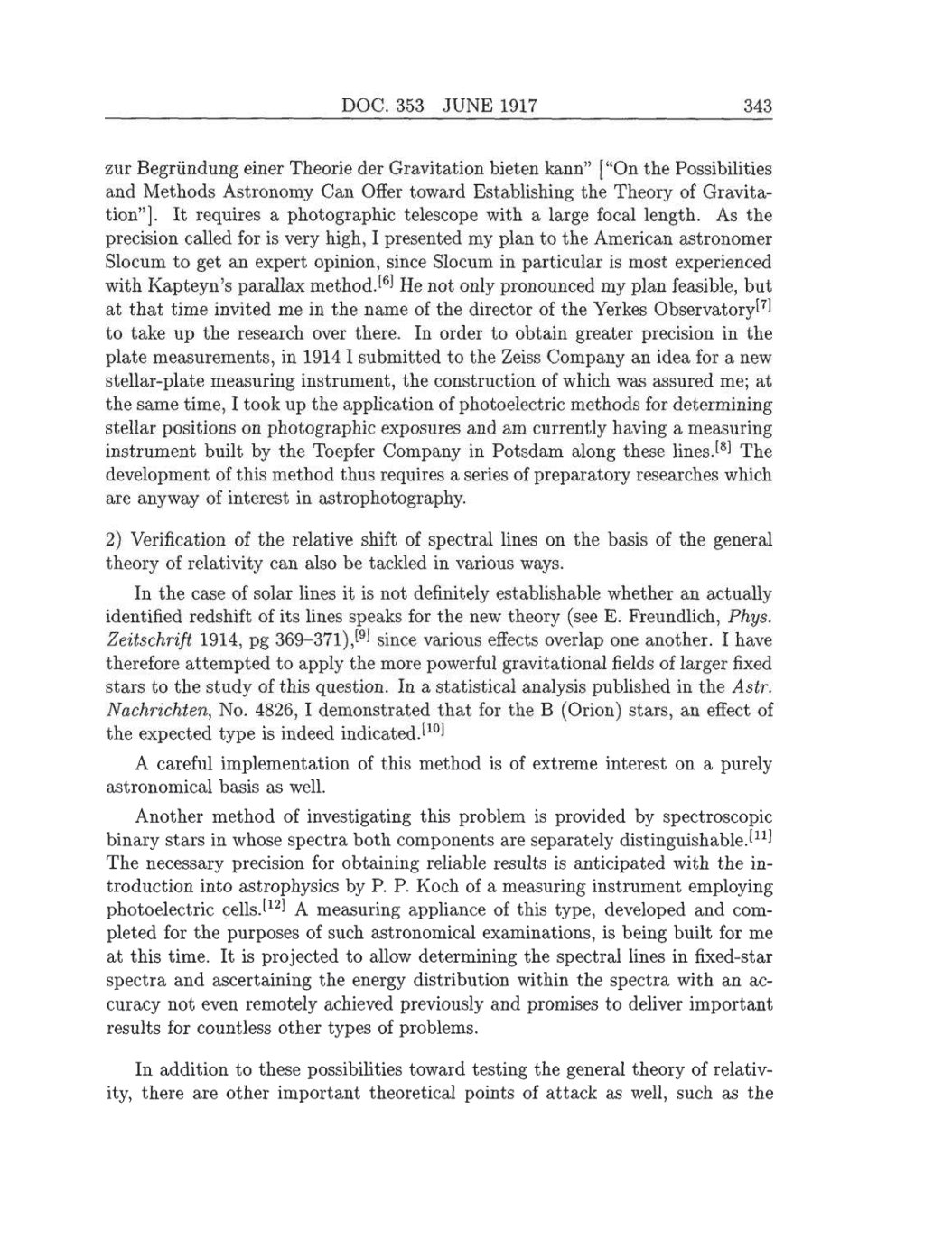DOC.
353
JUNE
1917
343
zur
Begründung
einer Theorie der
Gravitation
bieten kann”
[“On
the
Possibilities
and Methods
Astronomy
Can
Offer
toward
Establishing
the
Theory
of
Gravita-
tion”].
It
requires
a
photographic telescope
with
a
large
focal
length.
As the
precision
called for
is
very high,
I
presented my plan
to
the
American astronomer
Slocum to
get
an
expert
opinion,
since Slocum in
particular is
most
experienced
with
Kapteyn’s
parallax method.[6] He
not
only pronounced my plan feasible,
but
at
that
time
invited
me
in
the
name
of the director
of
the
Yerkes
Observatory[7]
to take
up
the
research
over
there. In
order to
obtain
greater
precision
in
the
plate
measurements,
in
1914 I
submitted
to
the
Zeiss
Company an
idea for
a new
stellar-plate
measuring
instrument,
the
construction
of
which
was
assured
me;
at
the
same
time,
I
took
up
the
application
of
photoelectric
methods for
determining
stellar
positions
on
photographic exposures
and
am
currently having
a
measuring
instrument built
by
the
Toepfer Company
in Potsdam
along
these
lines.[8]
The
development
of
this
method
thus
requires
a
series
of
preparatory
researches
which
are
anyway
of
interest
in
astrophotography.
2)
Verification of
the
relative shift
of spectral
lines
on
the
basis of
the
general
theory
of relativity
can
also be tackled in various
ways.
In
the
case
of solar lines
it
is not
definitely
establishable whether
an
actually
identified redshift of its
lines
speaks
for
the
new theory
(see
E.
Freundlich,
Phys.
Zeitschrift
1914,
pg
369-371),[9] since
various
effects
overlap
one
another.
I
have
therefore
attempted
to
apply
the
more
powerful
gravitational fields
of
larger
fixed
stars
to
the
study
of
this
question.
In
a
statistical
analysis published
in the
Astr.
Nachrichten,
No.
4826,
I
demonstrated that
for the
B
(Orion)
stars,
an
effect
of
the
expected
type is
indeed
indicated.[10]
A
careful
implementation
of
this
method
is of
extreme
interest
on a
purely
astronomical basis
as
well.
Another method
of
investigating
this
problem
is
provided by spectroscopic
binary
stars
in
whose
spectra
both
components
are
separately distinguishable.[11]
The
necessary precision
for
obtaining
reliable results
is anticipated
with the in-
troduction into
astrophysics by
P. P.
Koch
of
a
measuring
instrument
employing
photoelectric
cells.[12]
A
measuring appliance
of
this
type, developed
and
com-
pleted
for
the
purposes
of such astronomical
examinations,
is
being
built
for
me
at
this
time.
It
is projected
to
allow
determining
the
spectral
lines in fixed-star
spectra
and
ascertaining
the
energy
distribution
within
the
spectra
with
an ac-
curacy
not
even
remotely
achieved
previously
and
promises
to deliver
important
results for countless
other
types of problems.
In
addition
to these
possibilities
toward
testing
the
general
theory
of relativ-
ity,
there
are
other
important
theoretical
points
of
attack
as
well,
such
as
the
